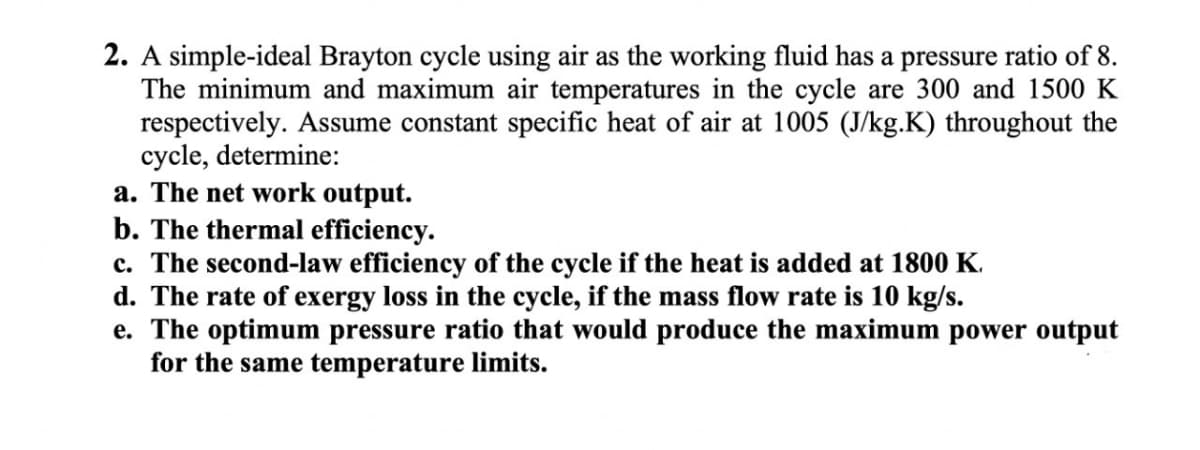2. A simple-ideal Brayton cycle using air as the working fluid has a pressure ratio of 8. The minimum and maximum air temperatures in the cycle are 300 and 1500 K respectively. Assume constant specific heat of air at 1005 (J/kg.K) throughout the cycle, determine: a. The net work output. b. The thermal efficiency. c. The second-law efficiency of the cycle if the heat is added at 1800 K. d. The rate of exergy loss in the cycle, if the mass flow rate is 10 kg/s. e. The optimum pressure ratio that would produce the maximum power output for the same temperature limits.
2. A simple-ideal Brayton cycle using air as the working fluid has a pressure ratio of 8. The minimum and maximum air temperatures in the cycle are 300 and 1500 K respectively. Assume constant specific heat of air at 1005 (J/kg.K) throughout the cycle, determine: a. The net work output. b. The thermal efficiency. c. The second-law efficiency of the cycle if the heat is added at 1800 K. d. The rate of exergy loss in the cycle, if the mass flow rate is 10 kg/s. e. The optimum pressure ratio that would produce the maximum power output for the same temperature limits.
Elements Of Electromagnetics
7th Edition
ISBN:9780190698614
Author:Sadiku, Matthew N. O.
Publisher:Sadiku, Matthew N. O.
ChapterMA: Math Assessment
Section: Chapter Questions
Problem 1.1MA
Related questions
Question
Solve all parts Asap

Transcribed Image Text:2. A simple-ideal Brayton cycle using air as the working fluid has a pressure ratio of 8.
The minimum and maximum air temperatures in the cycle are 300 and 1500 K
respectively. Assume constant specific heat of air at 1005 (J/kg.K) throughout the
cycle, determine:
a. The net work output.
b. The thermal efficiency.
c. The second-law efficiency of the cycle if the heat is added at 1800 K.
d. The rate of exergy loss in the cycle, if the mass flow rate is 10 kg/s.
e. The optimum pressure ratio that would produce the maximum power output
for the same temperature limits.
Expert Solution
This question has been solved!
Explore an expertly crafted, step-by-step solution for a thorough understanding of key concepts.
This is a popular solution!
Trending now
This is a popular solution!
Step by step
Solved in 6 steps with 5 images

Knowledge Booster
Learn more about
Need a deep-dive on the concept behind this application? Look no further. Learn more about this topic, mechanical-engineering and related others by exploring similar questions and additional content below.Recommended textbooks for you

Elements Of Electromagnetics
Mechanical Engineering
ISBN:
9780190698614
Author:
Sadiku, Matthew N. O.
Publisher:
Oxford University Press

Mechanics of Materials (10th Edition)
Mechanical Engineering
ISBN:
9780134319650
Author:
Russell C. Hibbeler
Publisher:
PEARSON

Thermodynamics: An Engineering Approach
Mechanical Engineering
ISBN:
9781259822674
Author:
Yunus A. Cengel Dr., Michael A. Boles
Publisher:
McGraw-Hill Education

Elements Of Electromagnetics
Mechanical Engineering
ISBN:
9780190698614
Author:
Sadiku, Matthew N. O.
Publisher:
Oxford University Press

Mechanics of Materials (10th Edition)
Mechanical Engineering
ISBN:
9780134319650
Author:
Russell C. Hibbeler
Publisher:
PEARSON

Thermodynamics: An Engineering Approach
Mechanical Engineering
ISBN:
9781259822674
Author:
Yunus A. Cengel Dr., Michael A. Boles
Publisher:
McGraw-Hill Education

Control Systems Engineering
Mechanical Engineering
ISBN:
9781118170519
Author:
Norman S. Nise
Publisher:
WILEY

Mechanics of Materials (MindTap Course List)
Mechanical Engineering
ISBN:
9781337093347
Author:
Barry J. Goodno, James M. Gere
Publisher:
Cengage Learning

Engineering Mechanics: Statics
Mechanical Engineering
ISBN:
9781118807330
Author:
James L. Meriam, L. G. Kraige, J. N. Bolton
Publisher:
WILEY